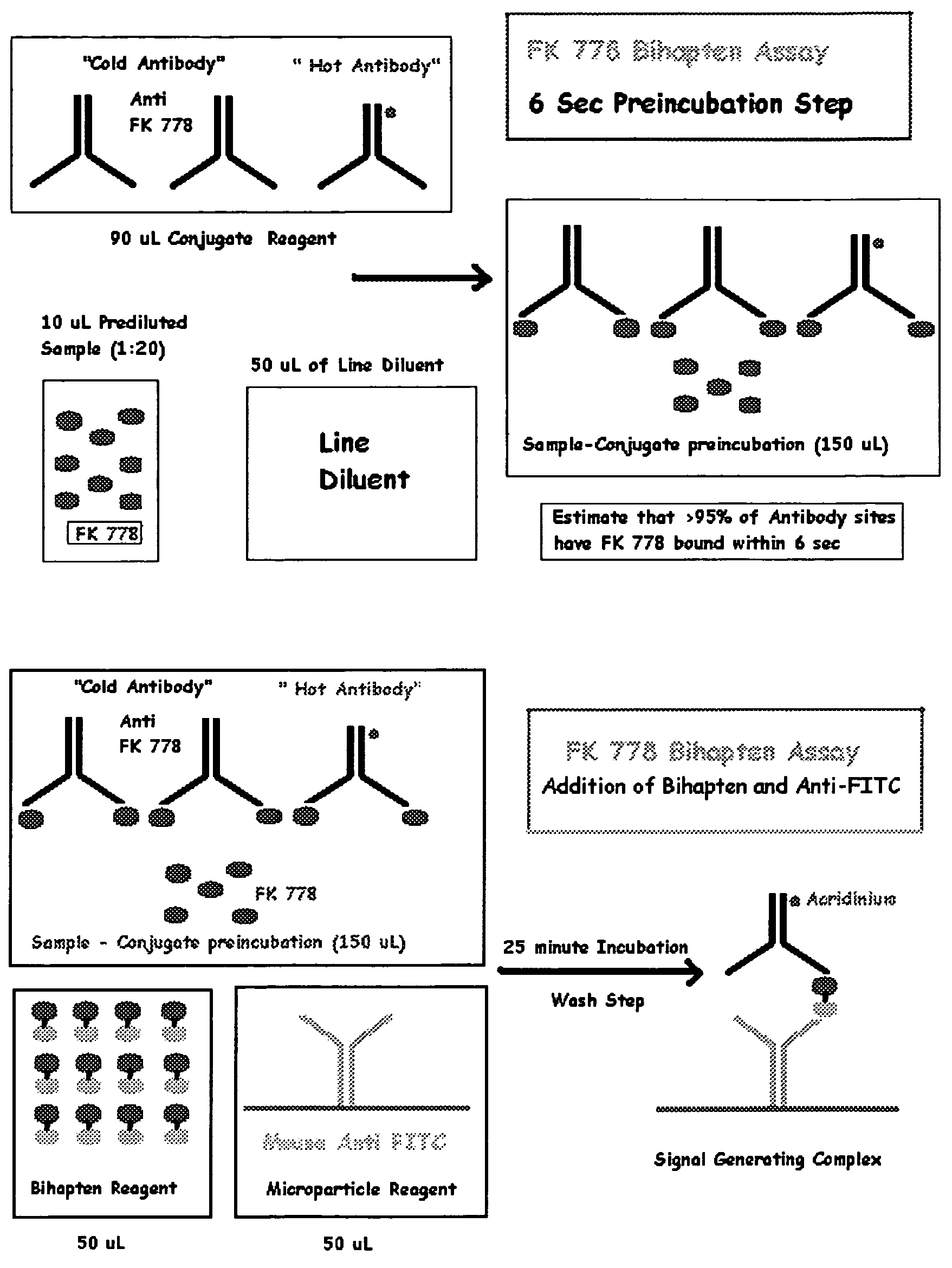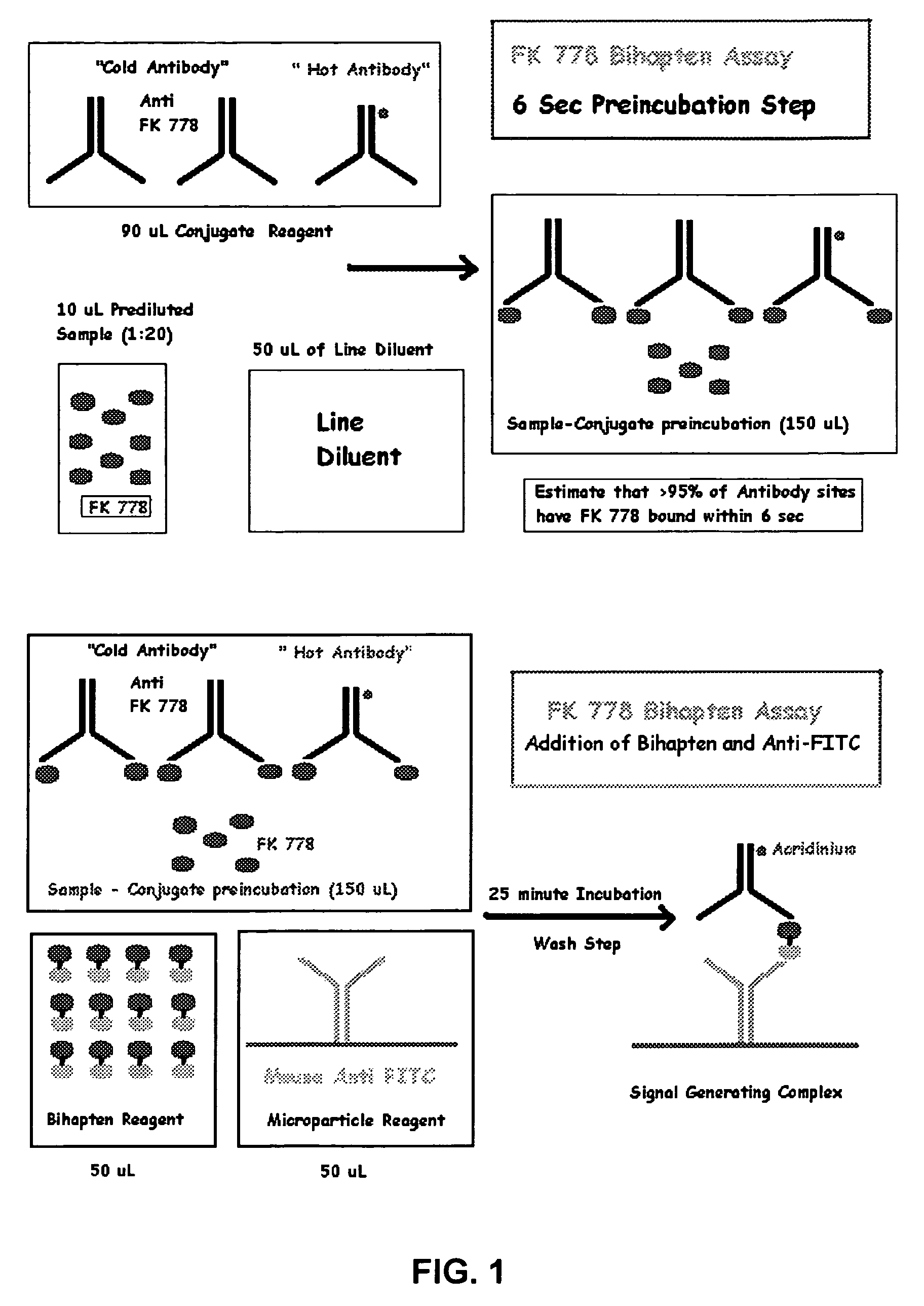Determination of concentration of FK778 by competitive immunoassay
a competitive immunoassay and concentration determination technology, applied in the field of detection and measurement of fk778 or analogues of fk778 in biological samples, can solve the problems of inability to detect a very potent label, unsuitable drugs for clinical transplantation, and inability to achieve sample dilution on an automated analyzer, so as to improve the performance of a given assay format
- Summary
- Abstract
- Description
- Claims
- Application Information
AI Technical Summary
Benefits of technology
Problems solved by technology
Method used
Image
Examples
example 1
[0093]FK778 assays were performed by an ARCHITECT® instrument, commercially available from Abbott Laboratories, Abbott Park, Ill., according to the following procedure. See also U.S. Pat. Nos. 5,795,784 and 5,856,194, both of which are incorporated herein by reference. A serum sample (10 μL) was diluted with Line Diluent at a ratio of 1 part sample to 20 parts Line Diluent. A portion of the diluted sample (10 μL) was mixed with 90 μL of Conjugate Reagent and 50 μL of Line Diluent. Magnetic Microparticle Reagent (50 μL) and Bihapten Tracer Reagent (50 μL) were added to the foregoing mixture after a period of six (6) seconds. The resulting mixture (250 μL) was incubated for 25 minutes. The microparticles were washed three (3) times with 1 mL of Line Diluent. The magnetic particles were attracted to a magnet at the same time that they were being washed. The washed microparticles were treated with Pretrigger Reagent (100 μL acidic hydrogen peroxide). Finally, the chemiluminescent reacti...
example 2
[0099]The following example illustrates one embodiment of the assay of this invention a fluorescence polarization immunoassay (FPIA) format.
[0100]Bihapten tracer (FK778 coupled to a fluorescein derivative) was diluted to a concentration of 2000 nM in IMx® FPIA line diluent (100 mM Phosphate Buffer, pH 7.5, 0.01% bovine gamma globulin, 0.1% sodium azide) to form the tracer reagent. Monoclonal antibody to FK778 was diluted to a concentration of 100 μg / mL in IMx® FPIA line diluent to form the antibody reagent. A third reagent, Lithium Dodecyl Sulfate (LDS) pretreatment reagent, was prepared by diluting 2% LDS into 100 mM Tris Buffer, pH 7.5, for a final concentration of 0.05% LDS. The LDS pretreatment reagent was used to release any FK778 or bihapten tracer bound to serum albumin in the sample. Calibrators and controls were prepared in a synthetic matrix and ranged in concentration from 0 to 250 μg / mL FK778.
[0101]A predilution step for the sample was performed in the IMx® instrument by...
example 3
[0103]The purpose of this example is to show preparation of antibody-coated microparticles. Microparticles coated with antibody were prepared as follows:
[0104]Microparticles were washed in bulk. MES buffer (32 mL) was transferred to a centrifuge tube (50 mL) by means of a pipette. Microparticles (8 mL, 5% solids) were added to the MES buffer in the centrifuge tube. The microparticles were separated from the buffer by means of externally applied magnetic force, and liquid was removed. The microparticles were resuspended in MES Buffer (40 mL). The microparticles were magnetized and liquid was removed. The microparticles were resuspended in MES buffer (32 mL, 1.25% solids).
[0105]The antibody is treated at low pH prior to addition to the microparticles. Anti-FITC antibody (5.55 mg / mL, 1.441 mL) was diluted with Phosphate Buffered Saline (PBS), pH 7.4 (2.559 mL) for a 2 mg / mL solution. PBS (4.0 mL, pH 1.7) was added to anti-FITC antibody (4.0 mL), the resulting solution (1 mg / mL) was inc...
PUM
| Property | Measurement | Unit |
|---|---|---|
| concentrations | aaaaa | aaaaa |
| concentrations | aaaaa | aaaaa |
| radii | aaaaa | aaaaa |
Abstract
Description
Claims
Application Information
 Login to View More
Login to View More - R&D
- Intellectual Property
- Life Sciences
- Materials
- Tech Scout
- Unparalleled Data Quality
- Higher Quality Content
- 60% Fewer Hallucinations
Browse by: Latest US Patents, China's latest patents, Technical Efficacy Thesaurus, Application Domain, Technology Topic, Popular Technical Reports.
© 2025 PatSnap. All rights reserved.Legal|Privacy policy|Modern Slavery Act Transparency Statement|Sitemap|About US| Contact US: help@patsnap.com



